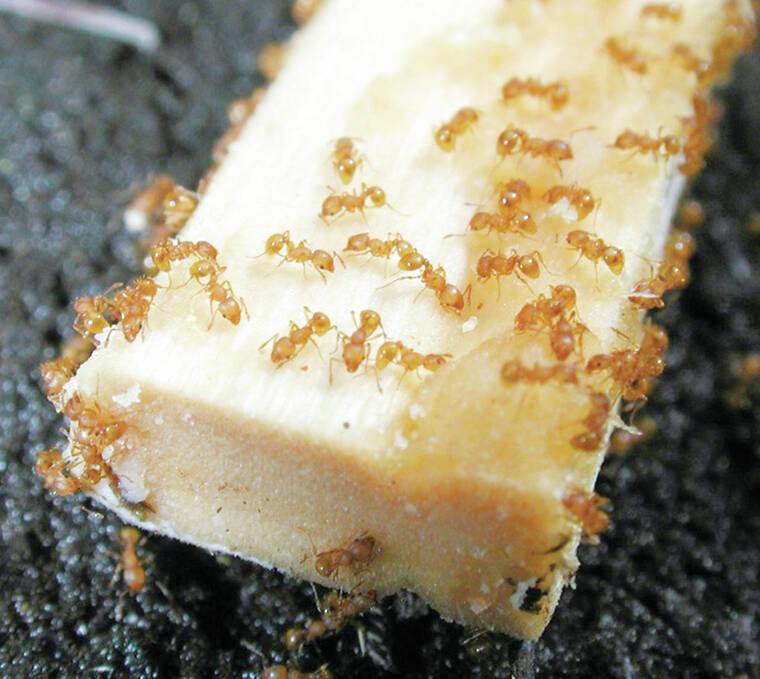MOLOA‘A — Island organizations are assembling to combat a little fire ant infestation reported on a North Shore farm earlier this month.
The Kaua‘i Invasive Species Committee, which is treating the over-13-acre infestation, has partnered with groups including the Hawai‘i Farm Bureau and Malama Kaua‘i to distribute free LFA test kits at venues including farmers’ markets.
The Moloa‘a infestation is the largest known on Kaua‘i. But the man who reported the tiny, invasive ants to the local hui believes the presence could have gone unnoticed for some time.
“It was a non-operational farm and nobody had been there for quite a while. But I’m the one that I guess stirred them up, because I started cleaning,” said John Kangas, a former tenant.
Kangas requested the name of the retired farm and his former landlord be withheld. “Because, you know, nobody intentionally brings fire ants to someplace,” he said.
Little fire ants, which may blind pets and livestock with their painful stings, have been described as pale orange, yellow-red to light brown in color. They measure one-sixteenth of an inch long — the thickness of a penny, according to the Hawai‘i Invasive Species Council.
Kangas described them as something gone one moment and here the next.
“One time I looked on top of a tractor and there was not one sign of an ant,” he explained. “I put a little bit of peanut butter on top of the tractor, I leave for five minutes, I come back and it is covered with ants.”
Creamy peanut butter is the key ingredient in KISC’s testing kit. Users are instructed to smear a thin layer on popsicle sticks spaced 10 feet apart along property borders. Any collected specimens should then be placed in a sealable plastic bag and frozen for 24 hours, before shipment or delivery to the KISC office in Kapa‘a.
Community-wide LFA surveys are needed due to the species’ aptitude for hitchhiking from one place to another, according to a sheet included in the testing kits.
KISC Outreach Coordinator Haylin Chock distributed the first round of LFA kits on Monday, at the Pau Hana Market at Kukui Grove Center in Lihu‘e. The crop-damaging pests pose a real threat to local agriculture, she said.
“If you were to have LFA, it can greatly impact their ability to come to market, their ability to sell to larger buyers like restaurants,” Chock explained. “They would have to go through much more protocols to make sure that their products were safe, that their saplings were safe if they were selling plant starters.”
Many sustenance farmers operate on Kaua‘i, according to Chock and Megan Fox of Malama Kaua‘i. Fox’s group, a nonprofit dedicated to increasing local food production and access, communicates regularly with over 300 such farmers.
Agriculture is one of Kaua‘i biggest exports due to seed companies and the Kaua‘i Coffee Company, county Office of Economic Development Director Nalani Brun said. However, the county does not have a more-specific statistic on hand, she said.
Malama Kaua‘i and KISC are collaborating to provide educational sessions on LFA-control measures to local farmers. Fox recommends those interested subscribe to the farmer e-newsletter at malamakauai.com for more information.
KISC declined to provide The Garden Island with any identifying information regarding the infested Moloa‘a farm or a description of its LFA-eradication methods, citing a commitment to confidentiality between KISC and landowners.
“We really rely on relationships and permission from people, and people being willing to share with us their space and letting us do our work for them,” Chock said.
•••
Scott Yunker, general assignment reporter, can be reached at 245-0437 or syunker@thegardenisland.com.





The residents of Kauai need to take action against this LFA infestation soon. Here on the Big Island it is a constant battle to maintain control of the spread. Tango bait works to supress the reproduction as per the LFA Ant Lab. At the worst case may have to have helicopter spraying like Maui.